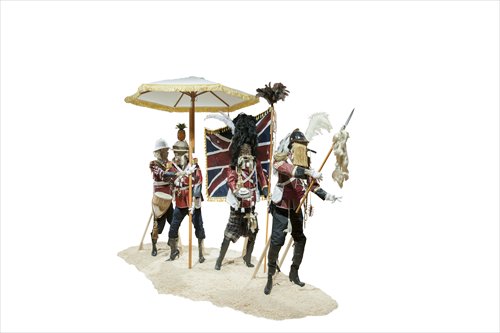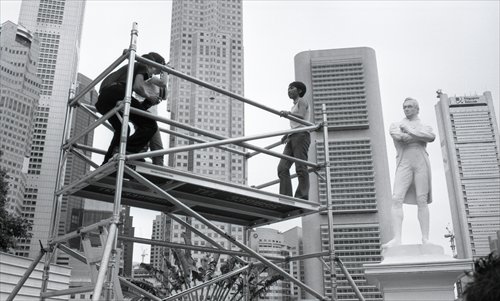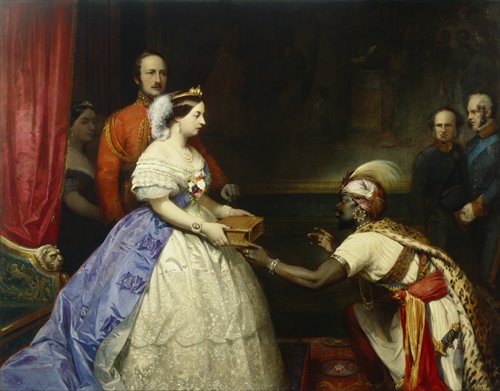ARTS / ART
New National Gallery Singapore exhibition explores the colonial legacies
‘Artist and Empire’

Scottish artist Andrew Gilbert's British Infantry Advance on Jerusalem, 4th of July, 1879 Photo: Courtesy of the National Gallery Singapore

Lee Wen's Untitled (Raffles) Photo: Courtesy of the National Gallery Singapore

Thomas Jones Barker's painting The Secret of England's Greatness (Queen Victoria Presenting a Bible in the Audience Chamber at Windsor) Photo: Courtesy of the National Gallery Singapore
One quick question: How are Australia, Brunei, Singapore, Malaysia, India and Myanmar similar?The answer: All of them were once colonies of the British Empire.
An ongoing exhibition at the National Gallery Singapore is looking back at that period of history through art associated with the British Empire to see how it has been represented and contested over time. Artist and Empire: (En)countering Colonial Legacies, which opened to the public on October 6, is broadening the scope of Artist and Empire: Facing Britain's Imperial Past exhibition that was presented at the Tate Britain art museum in November of 2015.
"When we first learnt that Tate Britain was organizing the exhibition, we were very keen to present a version of it in Singapore," said Eugene Tan, director of the National Gallery Singapore.
"Apart from the resonance that the exhibition has to the shared colonial history which Singapore and the region had with Britain's imperial past, it will also be a valuable counterpoint to reflect on the issues of post-colonialism and decolonization."
To accomplish this aim, the exhibition includes both historical and contemporary works from the region so that visitors can examine the art of the British Empire from alternative viewpoints, to include those of its former colonies and artists today.
"Unlike the London show, which took on a more British-centric perspective, we took Tate Britain's narrative as a point of departure to shift the curatorial focus and perspective to the former colonies from the Asia Pacific region, including responses to colonialism by contemporary artists," Tan added.
According to Low Sze Wee, director of curation, collections and education for the museum and curator of the exhibition, his team of curators approach the exhibition from two directions, which can be seen in the exhibitions' two sections.
The first section, Countering the Empire, adopts a contemporary perspective to critically examine art produced for the Empire with a contemporary perspective inserted into each theme, while the second section, Encountering Artistic Legacies, explores art produced during the transition from colony to nation-state as well as the relationship between the colonial experience and the rise of modern art in former colonies.
Contemporary views
From life-sized portraits of Singapore's key colonial figures such as Sir Stamford Raffles, who is regarded as the founder of modern Singapore, Queen Victoria and Queen Elizabeth II to a selection of contemporary artworks that introduce alternative perspectives on colonialism, the exhibition draws upon more than 200 artworks from regional and international collections both public and private including Singapore's National Collection, the British Museum, the National Portrait Gallery as well as the National Gallery of Australia and the Museum of Modern Art Tokyo.
At its peak in the 19th century, the British Empire once covered about 25 percent of the world's land surface. During that time, artworks were produced mainly by British artists or for British patrons. Some of the artworks on display at the exhibition commemorated events related to colonial expansion, while others focus on the peoples, flora and fauna of the colonies.
Singaporean artist Lee Wen's Untitled (Raffles) has been placed at the entrance of the exhibition, a response to the iconic sculpture of Sir Stamford Raffles that stands next to the Singapore River. The work consists a platform that the artist originally constructed beside the sculpture so people could look at Raffles at eye level for the first time.
According to Low, this artwork is just one of the many contemporary works interspersed throughout the exhibition that provides a critical perspective of the Empire. Opposite it is a large display area for Raffles, who has been portrayed as learned person of varied interests, especially in the natural history of the region, which led him to commission local artists in Malacca, Singapore and Bengkulu to paint the local flora and fauna.
"It (the exhibition) opens up fresh perspectives on how we can view Singapore and our region's colonial visual heritage. The Singapore show will offer visitors an opportunity to examine afresh our society today, and how we have built our senses of identity and place in relation to our past," Low said.
Evolution of local art
Against the background of increasing interaction between Britain and the colonies, as well as technological advances and increased ease of travel, local artists showed an increasing desire for self-determination and a deepening sense of self and nation.
One of the best ways to represent one's nation is to depict its local people, landscapes, flora and fauna, myths and legends and even everyday objects. This is reflected in the art of the period.
Techniques and materials used in art also underwent a shift during this time as local artists showed interest in major Western styles including impressionist techniques and Naturalism. Many ethnic Chinese artists in Malaya created artworks that combined traditional Chinese watercolors and Western oil paintings. Artists in India looked to ancient murals, medieval Indian miniatures as well as Japanese ink wash techniques to differentiate their works from Western-style paintings.
In his foreword, Low writes, "The Gallery is mindful that the exhibition is about art rather than history. It does not seek to cast moral judgment on the past, which is something that cannot be erased. Instead, it prompts us to think about how artists imagined the British Empire and the different perspectives we can take when looking at works from the past."
The exhibition will run until March 26, 2017.

